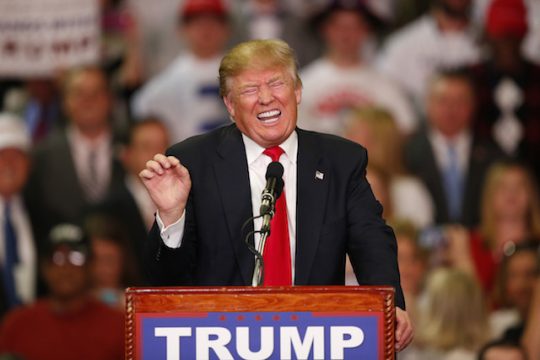Donald Trump was widely criticized after telling the New York Times last month that he would not offer military support to NATO allies attacked by Russia that have not "fulfilled their obligations to us."
Trump has also discussed not defending Japan and South Korea unless they "pay" more, even suggesting on the campaign trail that both longstanding American allies should get their own nuclear weapons to protect themselves, going against a decades-long bipartisan consensus on U.S. foreign policy and extended deterrence.
This sounds more like a shakedown of America’s closest allies rather than strategic thinking. Trump seems to view alliances as protection rackets meant to extract money in exchange for security—like a global Mafia boss. His language evokes historical memories of tribute-based systems, in which vassal states get shaken down by imperial "protectors."
Conservatives who defend Trump on this issue tend to argue he is simply saying NATO members should meet the alliance’s requirement to spend two percent of their GDP on defense, and that other allies should meet a similar standard—a point few people, including NATO itself, would dispute.
But there are two problems with this argument: America’s allies contribute far more than Trump and his supporters acknowledge, and Trump appears to be asking for something far more troubling than just increased defense spending.
If Trump’s point is about defense spending, then how does one explain his criticism of America’s allies in the Middle East, most notably Saudi Arabia?
"We are not being reimbursed for our protection of many of the countries that you’ll be talking about, including Saudi Arabia," Trump told the New York Times in March. "Without us, Saudi Arabia wouldn’t exist for very long. It would be, you know, a catastrophic failure without our protection … I mean they were making a billion dollars a day before the oil went down."
Yet Saudi Arabia spent 10.7 percent of its GDP on defense in 2014, the second most of any country in the world (next to Oman), and it spent an astounding 13.7 percent of GDP on defense in 2015, according to the Stockholm International Peace Research Institute (SIPRI). America, in comparison, spent 3.5 percent of its GDP on defense in 2014 and 3.3 percent in 2015.
Bahrain, which hosts the U.S. Navy’s Fifth Fleet, spent 4.4 percent in 2014 and 4.6 percent in 2015. Other American friends in the region have also surpassed Washington for 2014 and 2015, including Israel at 6.0 and 5.4 percent and Jordan at 4.3 and 4.2 percent, respectively. Numbers are unclear for the United Arab Emirates in 2015, but SIPRI estimates it spent 5.7 percent in 2014.
If Trump is still criticizing Middle Eastern allies for not paying enough for their own defense, then what is his measurement to be considered an ally? Other countries are also paying quite a bit, including NATO and Asian allies, but Trump still wants more.
Only five countries in NATO–the U.S., Greece, Poland, the United Kingdom, and Estonia–meet the two percent threshold, according to recent figures from the alliance. Virtually all supporters of NATO agree that more members should meet their obligations. But as the American Enterprise Institute’s Michael Barone wrote Monday, this does not mean the other countries fail to contribute. Many of them were there for the U.S. in Iraq and Afghanistan and have helped fight terrorism. Many are also doing more against Russia.
For example, Latvia and Lithuania, two Baltic states, are not wealthy but have made drastic increases in defense spending over the past two years. They understand better than America the threat Moscow poses. France is active with military deployments in Africa and the Middle East. Germany has, shall we say, historical reasons for not spending more on its military. Countries like Italy and Spain that are large have little excuse. Nor does Canada, but our friends to the north will be deploying 1,000 troops to Eastern Europe to deter Russian aggression. This will not show up in GDP figures but is a significant contribution.
In Asia, South Korea pulls its own weight. It spends 2.6 percent of GDP on defense and pays "about 50 percent of our personnel costs of being there," Army Gen. Vincent Brooks, the top U.S. commander in South Korea, told lawmakers in April. Brooks said it is cheaper for America to keep its forces in South Korea than in the U.S. The Korean government also provides $808 million to support U.S. troops in the region and is paying 92 percent of a $10.8 billion base relocation project in Korea. He also said that Japan–which is increasing its defense budget–provides about $2 billion for the maintenance and utilities of U.S. bases and facilities in the region.
The argument Trump’s supporters are making is factually flawed, but their argument is not necessarily Trump’s. When the candidate talks about allies paying more, he uses phrases like "reimbursing" America in a way that sounds strikingly like a shakedown, not simply a matter of higher defense spending. He is not just talking about NATO’s two percent threshold, or even referring to it at all.
"If [Japan and South Korea] don’t take care of us properly, if they don’t respect us enough to take care of us properly, then you know what’s going to have to happen … It’s very simple. They’re going to have to defend themselves," Trump told CNN this year.
These are the words of the emperor of Imperial China talking to tributary states on its periphery, or of Athenian leaders talking to Delian League members–not of an American president who believes in countering aggression with allies to promote a better world. Allies in Trump’s vision are vassals required to pay homage or be thrown to the wolves, not partners for a peaceful, stable, and just international order.
"Alliances are not to be measured in dollars, but in their effectiveness at deterring conflict," Allan R. Millett, a prominent military historian, said January. But for Trump, it’s all about the money.
